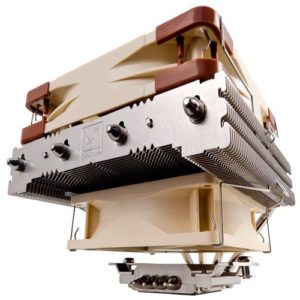The Low-Profile CPU Cooler Shootout: Striking a Balance
Introduction
If you’ve been looking to buy a low-profile CPU cooler for your compact PC, we’ve got a hunch you’re going to like what we have in store for you in this article. There are plenty of reviews out there testing the full range of coolers on the market, including most of the models we’ll be profiling in this article. But oftentimes, what you’ll find is a one-off review, which compares a particular cooler to whatever other coolers a particular media outlet has tested, be they similar or completely different. And when it comes to low-profile coolers, it’s typically the latter, which means you learn that the $40 low-profile cooler you’ve been eyeing performs a whole lot worse than a $120 liquid cooler. And therein lies the problem with typical cooler reviews on the Internet; they just aren’t all that helpful in actually choosing the right cooler for your particular needs.
And we’re on a mission to fix all that! In mid-2015, we published a comprehensive guide to CPU coolers, benchmarking six coolers featuring vastly different designs, from a low-profile 92mm model to a dual 120mm liquid cooler, using Intel’s Haswell-based Core i7-4770K as the test platform. That article was intended to give readers a sense of the range of coolers out there, rather than to choose the one best among many divergent designs. We followed up on that article with a 140mm Cooler Shootout to help our readers identify the very best 140mm coolers on the market, and now we’re doing the same for low-profile coolers. We believe that our readers are always going to be best served when we compare a number of products in the same price and performance classes, and more importantly, when we provide a deep dive into why some coolers perform better than others in a given test scenario.
Another pet peeve of ours is that many cooler reviewers use the same old PC platform they’ve been using for years, which allows them to compare coolers they tested 5 years ago to a cooler they’re testing today. But today’s CPUs aren’t comparable to older CPUs. In fact, the Core i5-6600K we’re using for this article runs much cooler than previous CPUs, changing the cooling equation substantially. Yes, you can go overboard with ultra-high-end coolers that could easily cool hotter-running CPUs from a few years ago, but why would you? And that’s why low-profile coolers deserve a fresh look on a modern platform, because in reality, they’re all just about any PC user really needs, even if most builders are drawn in by the allure of big radiators and multiple fans.
Luckily, due to all the groundwork we’ve laid with our previous CPU Cooler Reviews, a number of leading cooler manufacturers were eager to send in their best low-profile models for a shootout in which only one (or perhaps a few!) would survive. Here are the nine coolers we’re testing, along with their retail prices as of our publication date:
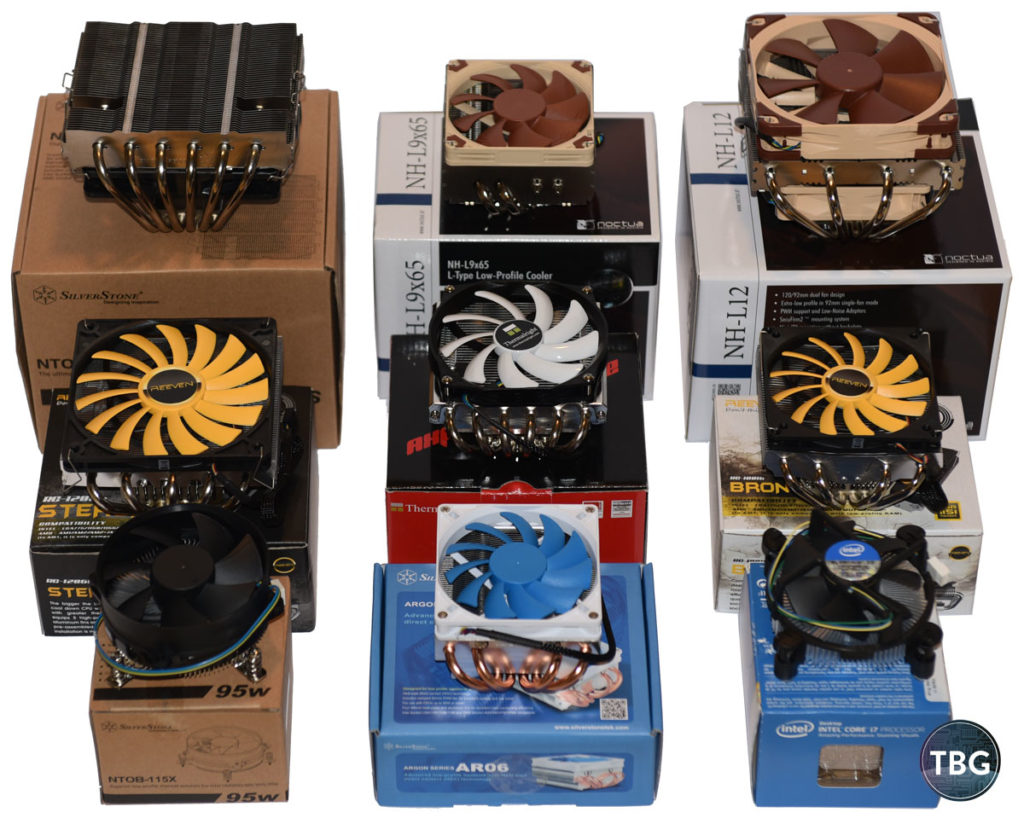
- Intel Reference Cooler (bundled with the Intel Core i7-4770K Processor)
- Noctua NH-L9x65 – $50 (special thanks to Noctua for providing this review sample)
- Noctua NH-L12 – $57 (special thanks to Noctua for providing this review sample)
- Reeven Brontes – $35 (special thanks to Reeven for providing this review sample)
- Reeven Steropes – $46 (special thanks to Reeven for providing this review sample)
- SilverStone NT08-115X – $23 (special thanks to SilverStone for providing this review sample)
- SilverStone AR06 – $40 (special thanks to SilverStone for providing this review sample)
- SilverStone NT06-Pro – $55 (special thanks to SilverStone for providing this review sample)
- Thermalright AXP-100 Muscle – $50 (purchased at retail)
Below you’ll find the specifications for each of the coolers we tested. Note that weights were taken on our own scale, as manufacturers do not have a standardized method for reporting weights. Some include just the heatsink, others the heatsink and fan, and others still the entire assembly, including brackets. Our weight measurements include the components that contribute to performance: the heatsink and fan.

To build the suspense, we’re going to give away just a little bit of our conclusion right up front: three of these coolers will suffer disqualifications for failing to fit properly on our mini-ITX test platform, and two of these coolers will be declared winners. Place your bets, ladies and gentlemen, because things are going to get interesting!
Test Method
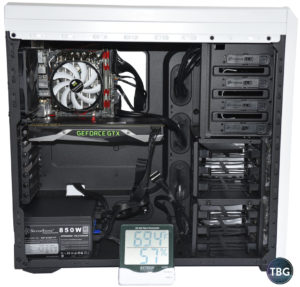
As we noted above, we’re using a current-gen benchmarking system featuring Intel’s Skylake platform. Here’s the setup we used to rate our contenders:
- CPU: Intel Core i5-6600K (overclocked to 4.4GHz)
- Motherboard: Asus Z170I Pro Gaming
- Memory: Corsair Vengeance LPX 2x8GB DDR4-3000
- Solid-State Drive: Samsung 850 Evo 500GB
- Video Card: Asus GeForce GTX 1070 8GB Founders Edition
- Power Supply: SilverStone PS-ST85F-PT 850W Platinum
- Case: Corsair Carbide 500R ATX
- Operating System: Windows 10 Home
To add a bit more challenge, we overclocked our 6600K to 4.4GHz. In past reviews, we’ve provided both stock and overclocked benchmarks, as do many other review sites, but in our opinion, trying to draw out differences between coolers using a stock-clocked Skylake CPU amounts to splitting hairs. There’s just not much cooling needed, so any difference might as well be within the margin of error. If you’re using a clock-locked processor or you’re not interested in overclocking your unlocked processor, you can honestly use any cooler, even Intel’s reference cooler included with non-K processors (Intel no longer provides one with K processors). There’s simply no way you’ll be able to overheat your CPU, and believe it or not, your system will run pretty quietly too, as we’ll show you in this review.
Eagle-eyed readers will note that we chose an unusual combination of a mini-ITX motherboard and an ATX case. We used an ITX motherboard to put each cooler’s small form factor credentials to the test, while using an ATX case to ease our burden in switching out coolers. As it turns out, the case we initially planned on using, the SilverStone Raven RVZ01-E, doesn’t provide access to the rear of the motherboard, meaning the motherboard would have to be removed for each installation – a major pain when installing so many coolers over a short period of time. More importantly, perhaps, is the fact that after having gone through the process of actually installing all the coolers, we found that several would have been impossible to properly install without access to the rear of the motherboard. While we had other ITX cases we could have used that did offer that access, they were too small for a number of our coolers, so in the end, we only had one reasonable choice: go ATX with the case. That being said, because we unplugged all of our case fans, the cooling setup ended up being fairly similar to what you might find in a cramped ITX case, although we couldn’t quite simulate total lack of airflow. That’s a serious concern in cases that put the power supply right over the CPU (a design approach we frown upon, by the way). If you have a Small Form Factor case with reasonably-good airflow around the CPU, our results will be fairly representative of what you might achieve with the coolers in this roundup. We know this because we actually tested a few inside an ITX case (the SilverStone RVZ02) and achieved similar results.
While in past reviews, we’ve used Noctua’s excellent NT-H1 Thermal Paste for every contender, after serious deliberation, we decided to use each cooler’s factory-supplied thermal paste for this shootout. Here’s our reasoning: if you’re shopping for $100+ coolers, you’re probably not going to mind spending another $8 or so on really good paste. But when you’re buying a cooler in the $30-$60 range, it’s less likely that such an investment will be appealing. Furthermore, in the competitive mid-range segment, Noctua’s coolers are at a disadvantage price-wise in part because they include excellent thermal paste, so we felt they should be given credit for this when other manufacturers may skimp on paste to drop the price a few dollars.
One final note on our test setup: we used an ultra-low-profile RAM kit from second-tier RAM vendor Team in order to give each of our coolers a fighting chance to fit. But this DDR4-3000 kit isn’t even capable of hitting its rated speed, which is why we don’t recommend it, and instead recommend Corsair every time. Several of our contenders did not fit using the Corsair RAM, and therefore will be receiving technical disqualifications.
To conduct our testing, we kept a thermometer at the base of our case, monitoring it to ensure we maintained a steady 69 °F, plus or minus 0.5 °F. Testing was halted if the ambient temperature varied by more than this amount. We used the application HWMonitor to collect CPU temperatures, selecting the “package” temperature reading, which always reflects the temperature of the hottest core, and we used an Android smartphone app (Sound Meter) to take sound readings.
All right, with that introduction out of the way, it’s time to get into the nitty-gritty of our results, starting with a review of installation!
Installation
While we couldn’t take numerous detailed photos of nine different cooler installations and keep this article a manageable length, we’re providing installation notes for each model below, along with one photo for each cooler. Feel free to click on any of the photos to get a full-size view.
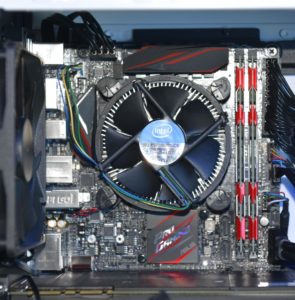
The Stock Intel Cooler
This cooler really needs no introduction, except perhaps to folks who are actually buying Intel’s latest generation of unlocked “-K” processors, which no longer include it. That’s a shame, because it’s a very good cooler for the price ($0). You might argue that the cooler wasn’t free, in that the cost was included in the price of previous-gen Intel processors, but alas, given that current-gen -K processors are actually more expensive than their forebears, that argument really doesn’t hold water. In reality, this is just a case of Intel trying to make a few more dollars on every CPU sale. It has nothing to do with the cooler’s ability to function correctly on -K processors, nor with cost savings being passed onto consumers who would likely upgrade the cooler anyway.
All this is to say that our reference Intel cooler came from an Intel Core i7-4770K processor, not the Core i5-6600K we were testing with. And as with all of Intel’s basic reference coolers over the years, this one uses plastic push-pins to attach to the motherboard. The more we use these, particularly in light of all the other mounting systems we’ve tested, the less we like them. The plastic push-pins may be attractive in the sense that they require no other hardware, nor access to the back of the motherboard, but they are actually harder to use than they should be, and often require a number of firm pushes to properly engage.
The one thing that the Intel cooler certainly has going for it is compatibility. Given that every motherboard and every case (save for a few ultra-thin models) is built around Intel’s CPU socket specification, you really shouldn’t have trouble fitting the Intel cooler in your system. There are no surprising overhangs nor challenging height issues to deal with. It just fits.
Noctua NH-L9x65
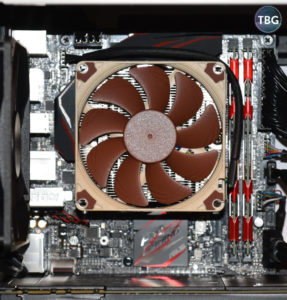 The NH-L9x65 uses Noctua’s well-designed SecuFirm2 mounting system, which employs a backplate behind the motherboard to improve to reduce the chance of warping, while also making installation easier overall. You will need access to the back of the motherboard, but that’s true of all but the Intel cooler in this roundup. The NH-L9x65 features captive spring-loaded screws attached to the heatsink, which connect to standoffs on either side of the motherboard. All told, this is a secure and safe method of attachment, with very little chance of bending the motherboard or CPU heat spreader due to over-tightening of the heatsink.
The NH-L9x65 uses Noctua’s well-designed SecuFirm2 mounting system, which employs a backplate behind the motherboard to improve to reduce the chance of warping, while also making installation easier overall. You will need access to the back of the motherboard, but that’s true of all but the Intel cooler in this roundup. The NH-L9x65 features captive spring-loaded screws attached to the heatsink, which connect to standoffs on either side of the motherboard. All told, this is a secure and safe method of attachment, with very little chance of bending the motherboard or CPU heat spreader due to over-tightening of the heatsink.
Noctua NH-L12
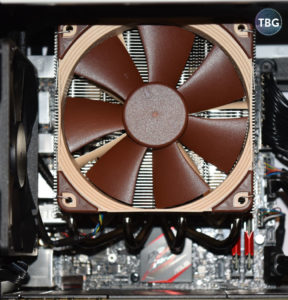 Noctua informed us prior to testing that a new version of the NH-L12 will be arriving sometime in the near future, and we’re pretty sure the number one priority for that new model will be to get rid of the first-generation SecuFirm bracket, which has been copied by other manufacturers (most notably in this roundup the SilverStone with its NT06-Pro), but pales in comparison to the SecuFirm2’s ease of use. You have to install each post individually through the backplate, and then hold them in place while attaching the standoffs on either side of the CPU. Adding to the complexity of the installation is the fact that you need to thread your screwdriver through several fan blades to secure the heatsink, unless of course you choose to remove the top fan during installation and then re-install it. At least the NH-L12 has captive spring-loaded screws and a fixed locking plate, meaning you don’t need four hands to install it!
Noctua informed us prior to testing that a new version of the NH-L12 will be arriving sometime in the near future, and we’re pretty sure the number one priority for that new model will be to get rid of the first-generation SecuFirm bracket, which has been copied by other manufacturers (most notably in this roundup the SilverStone with its NT06-Pro), but pales in comparison to the SecuFirm2’s ease of use. You have to install each post individually through the backplate, and then hold them in place while attaching the standoffs on either side of the CPU. Adding to the complexity of the installation is the fact that you need to thread your screwdriver through several fan blades to secure the heatsink, unless of course you choose to remove the top fan during installation and then re-install it. At least the NH-L12 has captive spring-loaded screws and a fixed locking plate, meaning you don’t need four hands to install it!
By the way, we should note that Noctua markets the NH-L12 as having two modes: dual-fan mode, and “low-profile” mode, which uses just the lower 92mm fan to achieve a height of 66mm. We chose to only test the cooler at full strength, as we don’t think it would make sense to buy this model and not run it with the larger fan.
Reeven Brontes
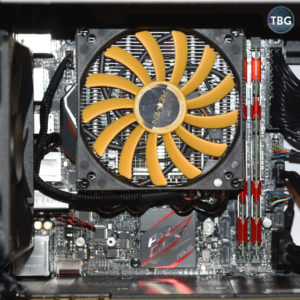 The Brontes turned out to be one of the easiest coolers to install. Using a simple attachment design (screws through the back of the motherboard attach to wings on the heatsink), this installed in just a few minutes. And due to the well-designed cutouts on the underside of the heatsink, the Brontes had no trouble with RAM clearance on either RAM kit we tried (ultra-low-profile as well as standard low-profile). Another bonus for ITX builders: the frame of the Brontes does not overhang the motherboard’s perimeter, meaning you will not end up running into the side or top panel of your case with the Brontes.
The Brontes turned out to be one of the easiest coolers to install. Using a simple attachment design (screws through the back of the motherboard attach to wings on the heatsink), this installed in just a few minutes. And due to the well-designed cutouts on the underside of the heatsink, the Brontes had no trouble with RAM clearance on either RAM kit we tried (ultra-low-profile as well as standard low-profile). Another bonus for ITX builders: the frame of the Brontes does not overhang the motherboard’s perimeter, meaning you will not end up running into the side or top panel of your case with the Brontes.
The one thing we don’t like about the mounting system used by the Brontes (as well as the Reeven Steropes and the SilverStone AR06) is the fact that you must hold the cooler in place with one hand while affixing the screws through the back of the motherboard with the other hand. If you don’t have a magnetic screwdriver, this could virtually require that you have three hands!
Reeven Steropes
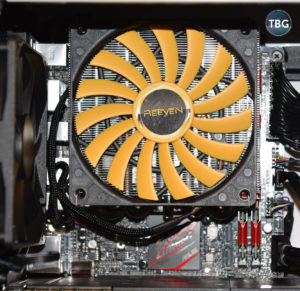 When Reeven reached out to us about its low-profile coolers, we originally requested only the Brontes. We were pretty sure the Steropes would not fit on our ITX motherboard. Reeven, however, was insistent, and provided the Steropes along with its opinion that it would definitely fit.
When Reeven reached out to us about its low-profile coolers, we originally requested only the Brontes. We were pretty sure the Steropes would not fit on our ITX motherboard. Reeven, however, was insistent, and provided the Steropes along with its opinion that it would definitely fit.
Well, here’s how that all played out: using our ultra-low-profile DDR4 kit, purchased specifically for testing low-profile coolers, the Steropes did indeed fit, with about 2mm to spare above our RAM’s heatsinks. But using the most popular low-profile RAM design on the market, our Corsair Vengeance LPX, the Steropes simply could not be used. We went ahead and tested it with our ultra-low-profile kit, but it will not be receiving any awards, regardless of performance, because we consider it to be technically disqualified.
And that’s not the Steropes only challenge. In fact, while it uses the same simple bracket design as the Brontes (screws go through the back of the motherboard, attaching to metal wings on the heatsink body), it presented a unique challenge. If your case doesn’t have rear motherboard access, you simply cannot build your system properly. That’s because once you’ve installed it, it blocks access to one of the four motherboard attachment points, leaving only three screws with which to secure the motherboard. While you can certainly operate a PC with that screw missing, we wouldn’t recommend transporting it, especially with the significant weight of the Steropes hanging off of it, which is doubly-concerning given the lack of a backplate on this relatively-large cooler.
But we’re not done yet: the Steropes overhung our motherboard’s perimeter by about half an inch, meaning that it will not fit in some cases even if there’s enough clearance above the CPU. We’ll have a bit more to say about the Steropes in our conclusion, as despite all of its challenges, we still appreciated what Reeven tried to do with the Steropes.
SilverStone NT08-115X
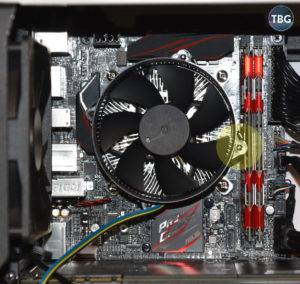 Well, this is going to end up being a short story. We were excited to try out the brand-new SilverStone NT08-115X for a number of reasons. First, it would be a great low-cost option for users of the Intel Core i5-6600K CPU that we used, as well as the Core i7-6700K, neither of which come with coolers, as discussed above. The cooler appears to fit in the exact same space as the stock Intel cooler, but features a larger fan and a bigger heatsink. It’s also designed exclusively for the Intel 115X platform, making it all the more obvious that SilverStone really is targeting Intel’s latest generation of CPUs. It cannot be used for AMD processors, nor for Intel’s High-End Desktop processors (i.e., the six-core, eight-core, and ten-core models). Finally, it has an ultra-simple and sturdy mount design, featuring a metal bracket for the rear of the motherboard, and four pre-installed spring-loaded screws to attach the heatsink to the bracket.
Well, this is going to end up being a short story. We were excited to try out the brand-new SilverStone NT08-115X for a number of reasons. First, it would be a great low-cost option for users of the Intel Core i5-6600K CPU that we used, as well as the Core i7-6700K, neither of which come with coolers, as discussed above. The cooler appears to fit in the exact same space as the stock Intel cooler, but features a larger fan and a bigger heatsink. It’s also designed exclusively for the Intel 115X platform, making it all the more obvious that SilverStone really is targeting Intel’s latest generation of CPUs. It cannot be used for AMD processors, nor for Intel’s High-End Desktop processors (i.e., the six-core, eight-core, and ten-core models). Finally, it has an ultra-simple and sturdy mount design, featuring a metal bracket for the rear of the motherboard, and four pre-installed spring-loaded screws to attach the heatsink to the bracket.
Perfect, right? Not so fast. It looks like SilverStone may have rushed through the testing phase for this cooler in order to get it to market quickly. In short, it’s completely incompatible with the ITX format, for one simple reason: the fan shroud’s plastic retaining clips sit right above the RAM slots, as highlighted in the photo we’ve provided. While it seemed that the clips could be rotated somewhat to avoid the RAM slots, this would require disassembly of the cooler, which would likely void the warranty. In other words, this is where our testing of the NT08 ended. We couldn’t secure the right side of the cooler, as the fan shroud was actually sitting right on top of one of our ultra-low-profile DDR4 RAM sticks.
We know SilverStone will be reading this article, and we hope they’ll be able to remedy the flaw in the NT08’s design before extensive retail shipments have begun. It holds a lot of promise for builders on a budget, and we truly wish we could have tested it against the reference Intel cooler.
SilverStone AR06
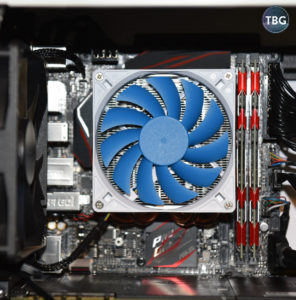 Luckily, SilverStone redeems itself with its excellent AR06 cooler. Featuring a simple but effective mounting system that takes all of five minutes to install, the AR06 is a pleasure to work with… as long as you have access to the rear of your motherboard. While no bracket is required, you actually have to affix the mounting screws through the back of the motherboard, into the AR06’s metal “wings.” While attaching large coolers without a rear-mounted backplate is asking for serious trouble (in the form of a warped motherboard), due to the lightweight nature of the AR06, that’s really not an issue here. But as with the Reeven twins, which use a nearly identical system, you practically need three hands to hold the cooler in place on one side of the board, while affixing the screws through the other side.
Luckily, SilverStone redeems itself with its excellent AR06 cooler. Featuring a simple but effective mounting system that takes all of five minutes to install, the AR06 is a pleasure to work with… as long as you have access to the rear of your motherboard. While no bracket is required, you actually have to affix the mounting screws through the back of the motherboard, into the AR06’s metal “wings.” While attaching large coolers without a rear-mounted backplate is asking for serious trouble (in the form of a warped motherboard), due to the lightweight nature of the AR06, that’s really not an issue here. But as with the Reeven twins, which use a nearly identical system, you practically need three hands to hold the cooler in place on one side of the board, while affixing the screws through the other side.
There is one potential pitfall in the AR06’s design in terms of clearance, and that is the four heatpipes, which protrude 1.3cm (about half an inch) out of the AR06’s heatsink. While it wasn’t an issue in our installation, there are some motherboards that may have cable headers or chipset heatsinks in the vicinity of these heatpipes, so if you’ll be using this cooler on an ITX board, make sure you scope out where these motherboard components could potentially interfere with the AR06’s heatpipes. We know, for example, that the AR06 will prevent the attachment of the USB 3.0 cable on Gigabyte’s line of Socket 1151-based ITX motherboards, including its GA-Z170N-WIFI and GA-Z170N-Gaming 5 models. On these boards, the AR06 will have to be oriented in the opposite direction if the USB 3.0 header is to be used.
SilverStone NT06-Pro
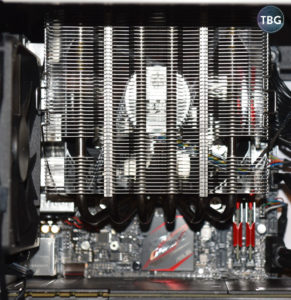 Time to be blunt: the NT06-Pro was an absolute pain to install, in fact offering up the most difficult installation process of any cooler we’ve ever tested. It’s just begging for a redesign, and in fact, we’re guessing it was never really designed to be installed with a fan at all. You see, the NT06-Pro began its life as the passive NT06, which used its excellent heatsink design to run on systems without the use of a cooling fan. That made it relatively easy to install, because you could slip your hand underneath and position its unusual floating bracket, while affixing it through the heatsink using a screwdriver. Well, with the NT06-Pro, that’s simply not possible, unless you install it in a case that affords you the luxury of clipping the fan on after you’ve attached the heatsink. And while our ATX case with a removable top would have allowed this, we weren’t going to bend the rules for the NT06-Pro, as few ITX cases would allow such access. And getting that floating bracket lined up underneath the fan without being able to actually see it or hold it, while affixing the two spring-loaded screws, literally took us about 25 minutes.
Time to be blunt: the NT06-Pro was an absolute pain to install, in fact offering up the most difficult installation process of any cooler we’ve ever tested. It’s just begging for a redesign, and in fact, we’re guessing it was never really designed to be installed with a fan at all. You see, the NT06-Pro began its life as the passive NT06, which used its excellent heatsink design to run on systems without the use of a cooling fan. That made it relatively easy to install, because you could slip your hand underneath and position its unusual floating bracket, while affixing it through the heatsink using a screwdriver. Well, with the NT06-Pro, that’s simply not possible, unless you install it in a case that affords you the luxury of clipping the fan on after you’ve attached the heatsink. And while our ATX case with a removable top would have allowed this, we weren’t going to bend the rules for the NT06-Pro, as few ITX cases would allow such access. And getting that floating bracket lined up underneath the fan without being able to actually see it or hold it, while affixing the two spring-loaded screws, literally took us about 25 minutes.
Making matters worse was the fact that the NT06-Pro’s size meant that the CPU fan header and CPU power header were blocked once the cooler was in place, a problem we didn’t catch on to until after we’d affixed the cooler. So we had to go through the arduous process of screwing in that bracket twice. Not fun. For all these reasons, the NT06-Pro is never going to be our favorite cooler. And with just a few millimeters of clearance above our Corsair Vengeance LPX RAM, it narrowly avoided being disqualified for clearance. We had high hopes for its performance, though, and as you’ll see on the following pages, it did avail itself fairly well, except in one critical aspect of performance…
Thermalright AXP-100 Muscle
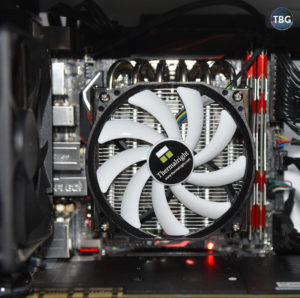 Thermalright AXP-100 uses an annoying floating bracket, similar to the SilverStone NT06-Pro, but because the heatsink is a lot smaller, it’s not quite as much of a pain to install. But it’s not great, and there’s no other way to put this: the AXP-100 took by far the longest to install of all the compact coolers due to the huge assortment of spacers, screws, brackets, and nuts required to affix it. Our hunch is that Thermalright could greatly simplify the installation procedure if it weren’t using a mounting system originally designed for its much larger tower-style coolers.
Thermalright AXP-100 uses an annoying floating bracket, similar to the SilverStone NT06-Pro, but because the heatsink is a lot smaller, it’s not quite as much of a pain to install. But it’s not great, and there’s no other way to put this: the AXP-100 took by far the longest to install of all the compact coolers due to the huge assortment of spacers, screws, brackets, and nuts required to affix it. Our hunch is that Thermalright could greatly simplify the installation procedure if it weren’t using a mounting system originally designed for its much larger tower-style coolers.
And then there’s the matter of clearance. As it turns out, the Muscle fails here, as it actually couldn’t even clear our ultra-low-profile RAM sticks. While we were able to get it to fit, the heatsink pushed against the left RAM stick, causing it lean over by a millimeter or so while putting extreme pressure on our motherboard’s first RAM slot. And this renders the AXP-100 technically disqualified from winning an award, regardless of its performance. We would never recommend that builders use it with our test configuration. Yes, we tried orienting it in other directions, but no matter what, it hit some component on our motherboard, whether it was the PCIe slot, the WiFi module, or the upper heatsink.
One bit of good news: the white-on-black color scheme of the Muscle’s fan will likely go with plenty of builds, unlike the beige, yellow, and blue of its competitors!
Summary Notes
The coolers we tested really fall into two categories when it comes to installation: those that conform to the Intel “keepout” area measuring 95mm x 95mm, and those that do not. Only the Intel heatsink, the Noctua NH-L9x65, and the SilverStone AR06 fall into the former category, and the AR06 in fact cheats a bit with its protruding heatpipes. All the other heatsinks are larger in terms of their perimeter, which may cause challenges with certain motherboards. Most builders probably know to check the CPU height clearance for their cases, as this is an advertised specification on all new case models (at least those that are worth considering, that is), but width and length are impossible to plan around, as you can’t get a specification of a motherboard’s clearance, nor a case’s tolerance for coolers that extend beyond the motherboard’s perimeter. In other words, picking coolers for small form factor PCs is tricky. We’ve tried to do our best here to point out the pitfalls, but given that mini-ITX motherboards can use very different layouts, we’ll have to leave it up to our readers to determine whether a particular cooler will work with their unique combination of components. Another important note: coolers that use heatpipes should be oriented with the heatpipes facing down, if possible. With our Thermalright cooler above, we weren’t able to fit it that way, but you’ll note that with every other cooler that features an array of heatpipes, the heatpipes were indeed facing down.
For those keeping score, three of our nine contenders have already been disqualified: the SilverStone NT08-115X, which could not be installed at all, the Thermalright AXP-100 Muscle, which pressed heavily against one of our ultra-low-profile RAM sticks, and the Reeven Steropes, which failed the compatibility test with our standard Corsair Vengeance LPX RAM. Of these three, only the NT08-115X’s issues were so serious that they’ll keep it from appearing in the charts that follow on the next few pages.
All right, it’s time to look at some benchmarks!
Performance (PWM-Controlled)
We begin our benchmarks with PWM-controlled results, using a custom fan profile set using our Asus motherboard’s AISuite software. In short, we went with a “silent” profile, which only ramps up the fan once the CPU hits 75 °C. It reaches 100% fan speed at 90 °C. Note that the fans from the various manufacturers behave quite differently under PWM control, which is why we think it’s always important to include this testing. Some fans have very broad RPM ranges, while others have narrow ranges, which typically tend to be on the upper-end of the noise spectrum.
First up, idle numbers. Note that while our processor is overclocked, it still enters an idle state, reducing voltage substantially.
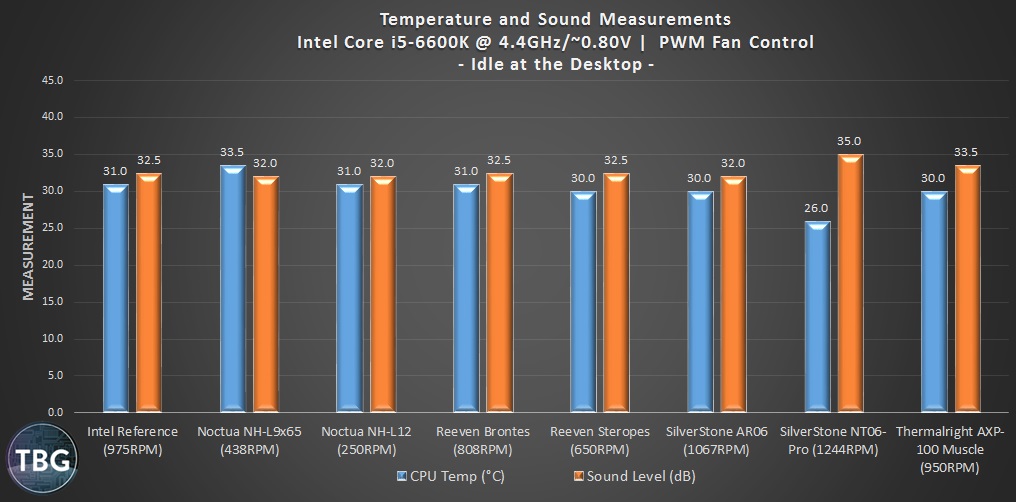
We’ve included rotational speeds in this chart because they have such a profound effect on the results that matter. If you’re focusing on temperature reading in the graph above, we suggest you do otherwise. At idle, noise is what counts. The winners here, by the slightest of margins, are the two Noctua offerings, along with the SilverStone AR06. The Noctua coolers achieve this through ultra-low rotational speed, which is simply unattainable with most fans. This is a testament to the quality of Noctua’s premium fans, which you of course pay for in the retail prices of Noctua coolers. The SilverStone can’t go nearly as low in terms of RPMs, but it’s of equally good quality in terms of sound levels. On the other end of tolerable is the SilverStone NT06-Pro, which may catch your eye with its amazingly-low temperature, but would also catch your ear if you had it installed in your system, as it’s extremely loud. It’s rated to go down to 1000RPM, but we couldn’t get it below 1244RPM, which was just too loud. And the other coolers that get the short end of the stick are the Reeven twins, which can go fairly low in terms of RPMs, but emit a bearing noise that’s quite scratchy, likely due to the ultra-thin bearing required for such slim fans. The Thermalright AXP-100 suffers from the same problem, and it’s actually worse off because its fan has a very high minimum rotational speed.
So to summarize, when it comes to idle noise, you want a fan that can spin slowly, but you also need it to have high-quality bearings. Only the Noctua coolers pass this test with flying colors.
Next up, a look at cooling while running the Intel Extreme Tuning Utility (XTU) benchmark, which nicely simulates intensive games without needing to load up the video card and thereby skew the noise testing results.
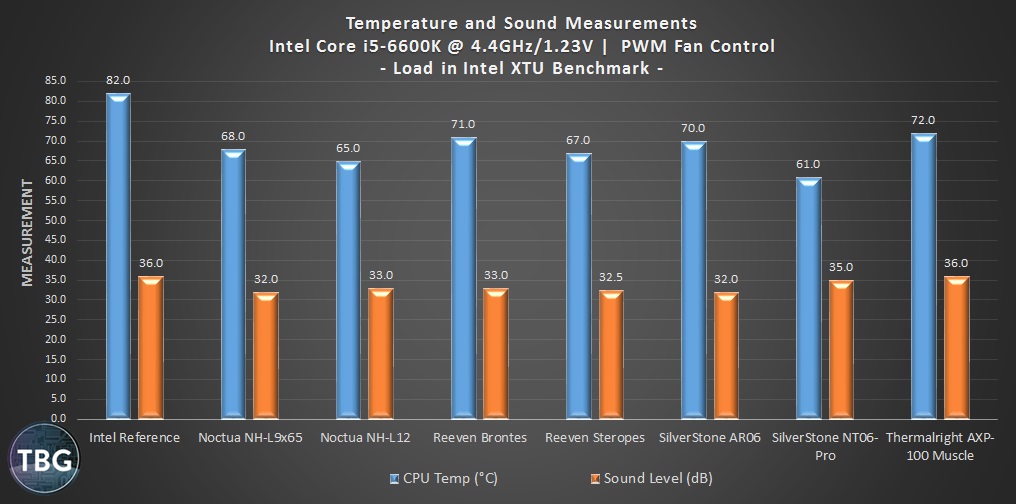
In this test, the SilverStone NT06-Pro dominates, at least in terms of performance. But alas, it’s running faster than it needs to, and thus generating more noise than it should. Only the vastly inferior Intel cooler and the Thermalright AXP-100 are louder. The coolers that really grab our attention in this test are the same ones that triumphed at idle: the Noctua NH-L9x65 and NH-L12, along with the SilverStone AR06. They offer excellent thermals (for their respective sizes), along with very good noise levels. Just behind them in the standings is the Reeven Steropes, which provides excellent thermals and very good noise levels. Again, it has a somewhat raspy quality to its fan bearings, which isn’t entirely picked up by a sound meter, so in ranking it below the other three coolers here we’re adding a bit of subjective evaluation that doesn’t quite appear in the charts.
Finally, we illustrate cooling performance faced with the insane load generated by Intel Burn Test. We don’t think any application will put this much pressure on a CPU, so consider this an absolute worst-case scenario.
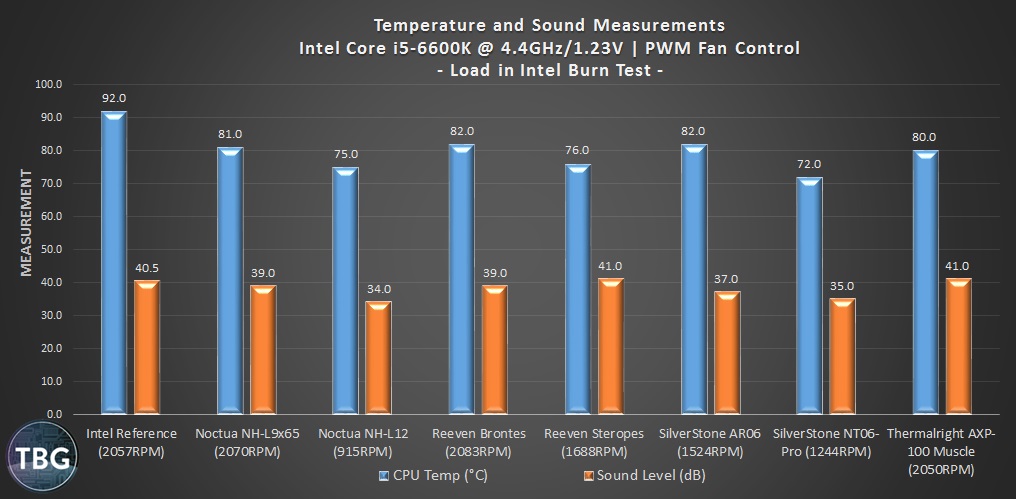
The good news: all of our coolers easily passed 10 cycles of this test without even coming close to the 100 °C thermal throttling threshold of the Core i5-6600K. We mentioned this in the introduction, but we’ll say it again here: the latest-gen Intel CPUs run incredibly cool, so much so that it’s essentially impossible to force the Intel reference cooler into failure mode. A shame, then, that Intel isn’t including it the box with its high-end CPUs anymore. Cost savings for Intel, a complete loss for consumers…
Among the aftermarket models, we see a slight change in the rankings versus the previous two tests. We’ve included the maximum rotational speed each cooler hit in the table above to give you more insights into why some were quieter than others. Nearly all the coolers are forced to seriously ramp up their RPMs, so we see the Noctua NH-L9x65 and the Reeven Brontes start to struggle, hitting noise levels of 39dB, while the Reeven Steropes and the Thermalright AXP-100 surpass that threshold, making them very, very loud. The Steropes in particular was disappointing, as its 120mm fan, which runs at well below 2000RPM in this test, should have allowed it to remain relatively quiet, but for the fact that it’s too big for its bearings. There’s no other way to explain why it’s louder than the Brontes, despite running at much lower RPMs.
Among the smaller coolers, we like the SilverStone AR06 the most here. Sure, it’s not producing the best thermal results, but they are well within the safe zone, and the cooler is impressively quiet. But the real winner, ironically enough, is the cooler that disappointed in the first two tests: the SilverStone NT06-Pro. It’s the only cooler that doesn’t need to ramp up its fan at all under Intel Burn Test, in part because it was running so fast to start with. But there’s no arguing with the results: the cooler dominates. The Noctua NH-L12, which in theory could give it a run for its money, has such a broad RPM range that it’s constantly ramping up and down, and under the stress of IBT, it simply can’t ramp up fast enough. As you’ll see on the next page, it regains its composure when operated at a fixed RPM.
Performance (Fixed 1000 RPM)
One of the things that has always concerned us about the various CPU cooler tests you’ll find around the ‘net is whether they’re methodologically sound. The most common test you’ll see in tech publications is benchmarks using the maximum fan RPM, which is simply useless. Any of these fans when run at 100% will both be far more powerful than you need and far louder than you can tolerate. And it leads to an arms race by manufacturers to equip their coolers with faster fans than everyone else. That’s why so many of the coolers we’re testing have maximum rotational speeds well above 2000RPM. That’s just not reasonable from our point of view.
While the ideal test setup would probably be to pick a decibel level and find each cooler’s best results at whatever fan speed this equates to, dialing in a constant sound level for various models in various tests is a nearly impossible task. So we’ve done the next best thing: we’ve found the fan percentage setting for each model that equates to 1000RPM, a rotational speed that we think represents the sweet spot in terms of airflow and noise. The only problem: one of the coolers uses a fan that can’t get anywhere close to 1000RPM, and that’s the SilverStone NT06-Pro. Despite a rating range of 1000-2500RPM, it didn’t go any lower than 1244RPM on our motherboard, so we’re noting that in the charts below. That puts it at a thermal advantage and a should level disadvantage in these tests.
First up, idle numbers.
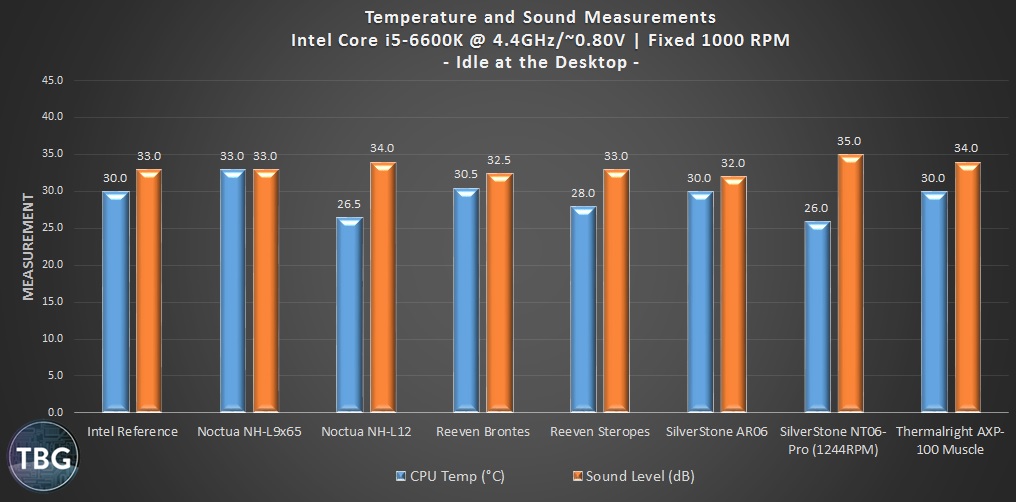
You can see now how closely matched the Noctua NH-L12 and SilverStone NT06-Pro are when they are running in the same general RPM range. These are both powerful coolers, and if we had a lot of extra time on our hands, we might have tested the NT06-Pro with the Noctua fan to see how well it could do with a fan that could actually run at 1000RPM. In any event, when it comes to idle numbers, we like quiet over extra-low temps, so we’ll call the NH-L12 the better of the two. But among the 120mm-class coolers, one model steals the crown here: the Reeven Steropes. Its slightly raspy fan didn’t do the cooler any favors in the idle PWM tests, where other fans could run in near silence, but at 1000RPM, the noise associated with air turbulence dominates, and it’s no louder than the others in that regard. In fact, it’s quieter than the Noctua NH-L12 here, which is handicapped by running two fans where one would be sufficient.
Among the smaller coolers, the SilverStone AR06 is just incredible, posting the lowest sound level while tying for the lowest temperature. It doesn’t hurt that it’s also among the least expensive coolers in this roundup. Well done, SilverStone!
Below, we have the Intel XTU results at 1000RPM:
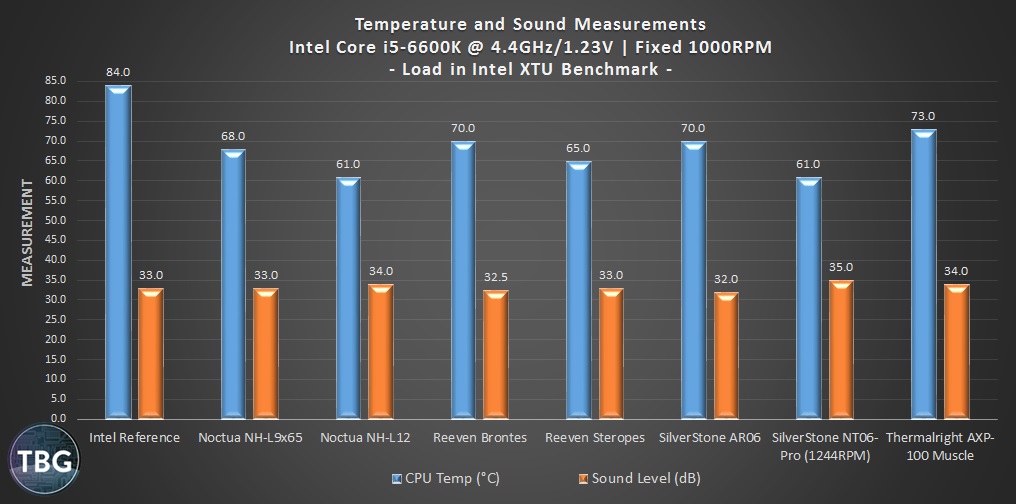
Remember, these are the results that we believe most closely approximate serious CPU loads in the real world. Given that all but one cooler is running at 1000RPM, we really start to see where different designs pull ahead. Among the 120mm-based coolers, the Steropes is again in a pretty good spot, running a bit hotter but noticeably quieter than the Noctua NH-L12 and SilverStone NT06-Pro, which are virtually tied. But it’s how the small coolers handle the heat that really deserves discussion. Here the Noctua NH-L9x65 and SilverStone AR06 are again at the top of the pack, beating or tying the other compact coolers in both temperature and noise levels. Impressive.
Finally, we illustrate cooling performance faced with the the artificially-high load generated by Intel Burn Test:

Here the Intel cooler nearly results in a throttling situation as it approaches 100 °C, but all the other coolers retain their composure. The clear winner is the Noctua NH-L12, which posts the best temperature and noise levels. Note that it does better here than under PWM control, where its ultra-low minimum RPM is a liability. With a fixed RPM, it just keeps cool and quiet. We also like the Reeven Steropes here, as it provide a nice middle-ground between the tall coolers and the ultra-compacts. But among those diminutive coolers, it’s harder to choose a winner. The Thermalright AXP-100 finally makes some headway, providing the lowest temperatures, but it’s just too loud, in part due to its terrible bearing quality. The Brontes is a bit better here, but it too has some annoying bearing noise, and the AR06 beats it anyway. In the end, the best tiny cooler in this absurdly-intense test is in fact the Noctua NH-L9x65, by a hair.
Now it’s time to sum up our findings and pick some overall winners!
The Winning Coolers
As discussed earlier, we tested each of the CPU coolers with our case fans turned off and with all fans set to run with automatic motherboard PWM controls and at a fixed 1000RPM. With this dual-pronged approach, we were able to assess both the quality of the fans and the effectiveness of the heatsink designs.
Among the coolers in this roundup, the competition was intense, but two rose to the top:
- Winning the award for the best high-performance low-profile cooler is the 93mm-tall Noctua NH-L12. While its mounting mechanism isn’t up to the standards of newer Noctua models, you’re still getting the best of the best in other regards, including the best fans and the best thermal paste, which combined with a solid, if not cutting-edge heatsink design, provides ample cooling power in a relatively compact design. We’d like to see Noctua add one or two more heatpipes, the updated SecuFirm2 bracket, and perhaps a slight offset to prevent it from overhanging the edge of the motherboard. But otherwise, this is the cooler to beat in our test, and its $57 price, as of our publication date, is more than fair given its quality. We can’t wait to see what Noctua has in store for the next version of the NH-L12, which if we’re lucky will be released sometime soon. [Update: after this article went to press, Noctua informed us that the successor to the NH-L12 will be arriving in Q1’17.]
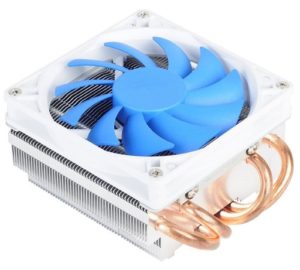
- Winning the award for the best ultra-low-profile cooler is the 58mm-tall SilverStone AR06. With a retail price of $40, it’s among the least expensive models in our roundup, and given its compact dimensions, it will fit in virtually any PC, even ones that can’t use competitors like the Noctua NH-L9x65 and Reeven Brontes. We also appreciated how simple it was to install and the excellent balance it strikes in terms of performance and noise. Simply put, the AR06 is a fantastic upgrade from the reference Intel cooler, and is truly all anyone but the most serious overclockers will ever need, given how efficient Intel’s latest CPUs are.
Now for the bad news. Three coolers were not even considered for an award because of disqualifications. First, we had to eliminate the SilverStone NT08-115X, which simply wouldn’t fit on our test motherboard, due to an unfortunate design oversight that we hope SilverStone can fix. [Update: after this article went to press, SilverStone informed us that they were aware of this issue and are changing their manufacturing method to reposition the fan shroud slightly to avoid such interference.]
Second, we have the Thermalright AXP-100 Muscle, which wouldn’t fit on our board without putting an unsafe amount of pressure on one of our ultra-low-profile RAM sticks. And yes, we tried all four orientations to give it the best possible chance of success. Frankly, it wouldn’t have won any awards anyway due to its below-average performance (in part caused by a sub-optimal heatpipe orientation) and above-average price.
Among the most promising coolers in our roundup, the Reeven Steropes, also suffered a disqualification, proving incompatible with our second set of RAM sticks, the mainstream Corsair Vengeance LPX. Due to the need to run ultra-low-profile RAM, the Steropes gets a failing grade, despite performing valiantly. Reeven should really look into redesigning the Steropes for slightly larger cases by raising the heatsink up above the RAM slots, and while they’re at it, endowing it with a quieter standard-thickness 120mm fan. It’s nifty that the Steropes is only 60mm tall, but it basically won’t work in any system that requires a cooler that short, so why not adapt the impressive Steropes design for cases that can use slightly taller coolers and avoid all the problems we encountered with the current Steropes? Reeven is relatively new to the cooler market, and we believe it has the potential to pose a serious challenge to the industry leaders with just a few revisions to its current lineup. In fact, we’re going to give the Steropes an Honorable Mention, as you’re about to learn! [Update: after this article went to press, Reeven informed us that a revised version of the Steropes is indeed in the works!]
Conclusion
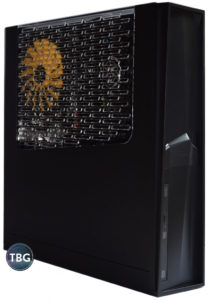 From the beginning, we made it clear that our goal was the to find the best low-profile cooler to use in an actual low-profile system. Well, in the end, we did indeed find the ideal cooler for our ITX motherboard of choice, the Asus Z170I Pro Gaming, used in this article, along with our slim case of choice, the SilverStone Raven RVZ02. And it’s the Reeven Steropes, one that we had to disqualify, as discussed above, but that truly deserves an Honorable Mention.
From the beginning, we made it clear that our goal was the to find the best low-profile cooler to use in an actual low-profile system. Well, in the end, we did indeed find the ideal cooler for our ITX motherboard of choice, the Asus Z170I Pro Gaming, used in this article, along with our slim case of choice, the SilverStone Raven RVZ02. And it’s the Reeven Steropes, one that we had to disqualify, as discussed above, but that truly deserves an Honorable Mention.
Why did we choose the Steropes for our own personal ITX system? Well, for two reasons. First, the reason it suffered a technical disqualification was that it didn’t work with standard DDR4 memory, but since we’d already invested in the only low-profile, high-speed kit on the market, we decided we might as well use it! Second, despite the fact that it measured 60mm tall, which was 2mm above the Raven’s stated CPU cooler headroom of 58mm, we were able to squeeze it in. In fact, there’s about 2mm of room to spare both between the cooler and the side panel and between the cooler and the top of the case. Talk about cutting it close! In all honesty, we can’t believe it actually fit, and we still strongly recommend our readers stick to published specs when trying to establish compatibility, but it’s definitely fun when you can bend the rules just a bit and come away unscathed!
We want to remind readers that the best use of any of the low-profile coolers profiled in this roundup is in systems that cannot fit tower-style coolers, which will outperform downdraft coolers, all else being equal. Among our favorites in that market are the Arctic Freezer i32 and Noctua NH-U12S, which will fit in almost any ATX case, and the larger Thermalright Macho Rev. B and Noctua NH-U14S, which require over 160mm of clearance but offer stellar performance at their respective pricepoints.
That’s all for now, but this isn’t the end of our CPU cooler coverage. To browse our top CPU Cooler picks at every price point, check out our CPU Cooler Buyer’s Guide, updated quarterly!

